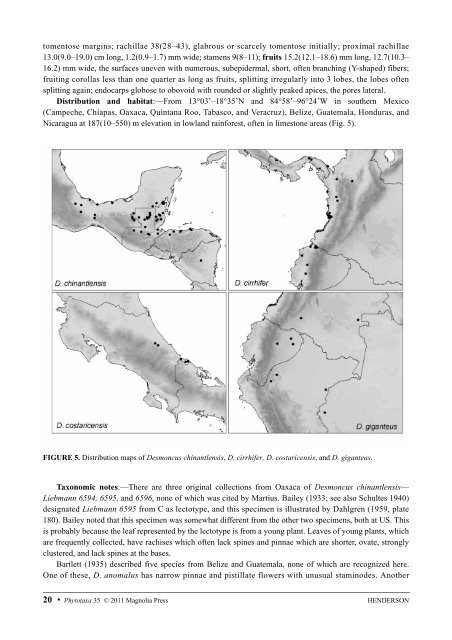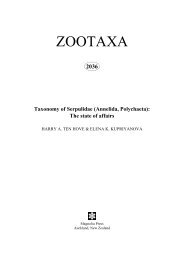Create successful ePaper yourself
Turn your PDF publications into a flip-book with our unique Google optimized e-Paper software.
tomentose margins; rachillae 38(28–43), glabrous or scarcely tomentose initially; proximal rachillae<br />
13.0(9.0–19.0) cm long, 1.2(0.9–1.7) mm wide; stamens 9(8–11); fruits 15.2(12.1–18.6) mm long, 12.7(10.3–<br />
16.2) mm wide, the surfaces uneven with numerous, subepidermal, short, often branching (Y-shaped) fibers;<br />
fruiting corollas less than one quarter as long as fruits, splitting irregularly into 3 lobes, the lobes often<br />
splitting again; endocarps globose to obovoid with rounded or slightly peaked apices, the pores lateral.<br />
Distribution and habitat:—From 13°03’–18°35’N and 84°58’–96°24’W in southern Mexico<br />
(Campeche, Chiapas, Oaxaca, Quintana Roo, Tabasco, and Veracruz), Belize, Guatemala, Honduras, and<br />
Nicaragua at 187(10–550) m elevation in lowland rainforest, often in limestone areas (Fig. 5).<br />
FIGURE 5. Distribution maps of Desmoncus chinantlensis, D. cirrhifer, D. costaricensis, and D. giganteus.<br />
Taxonomic notes:—There are three original collections from Oaxaca of Desmoncus chinantlensis—<br />
Liebmann 6594, 6595, and 6596, none of which was cited by Martius. Bailey (1933; see also Schultes 1940)<br />
designated Liebmann 6595 from C as lectotype, and this specimen is illustrated by Dahlgren (1959, plate<br />
180). Bailey noted that this specimen was somewhat different from the other two specimens, both at US. This<br />
is probably because the leaf represented by the lectotype is from a young plant. Leaves of young plants, which<br />
are frequently collected, have rachises which often lack spines and pinnae which are shorter, ovate, strongly<br />
clustered, and lack spines at the bases.<br />
Bartlett (1935) described five species from Belize and Guatemala, none of which are recognized here.<br />
One of these, D. anomalus has narrow pinnae and pistillate flowers with unusual staminodes. Another<br />
20 Phytotaxa 35 © 2011 <strong>Magnolia</strong> <strong>Press</strong><br />
HENDERSON
















